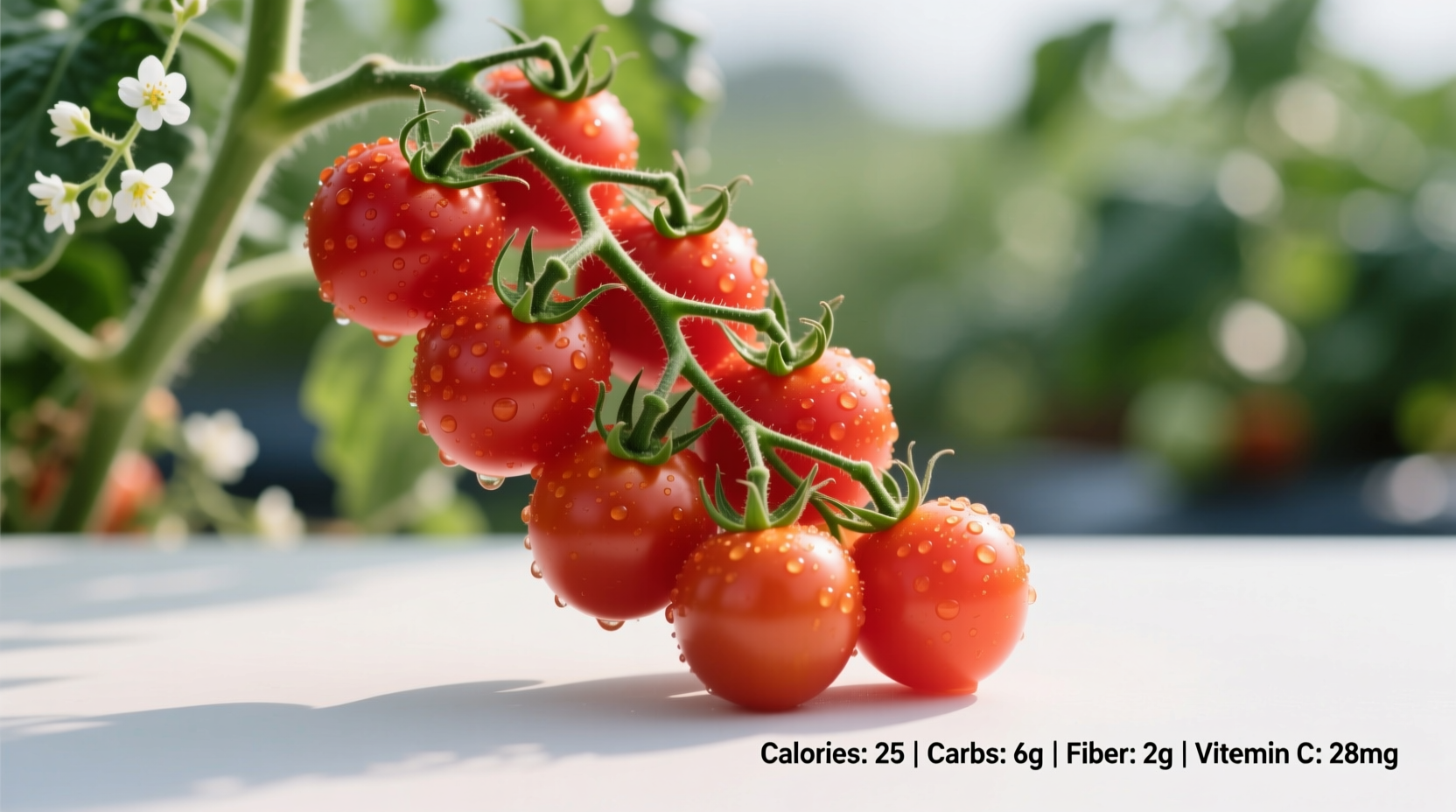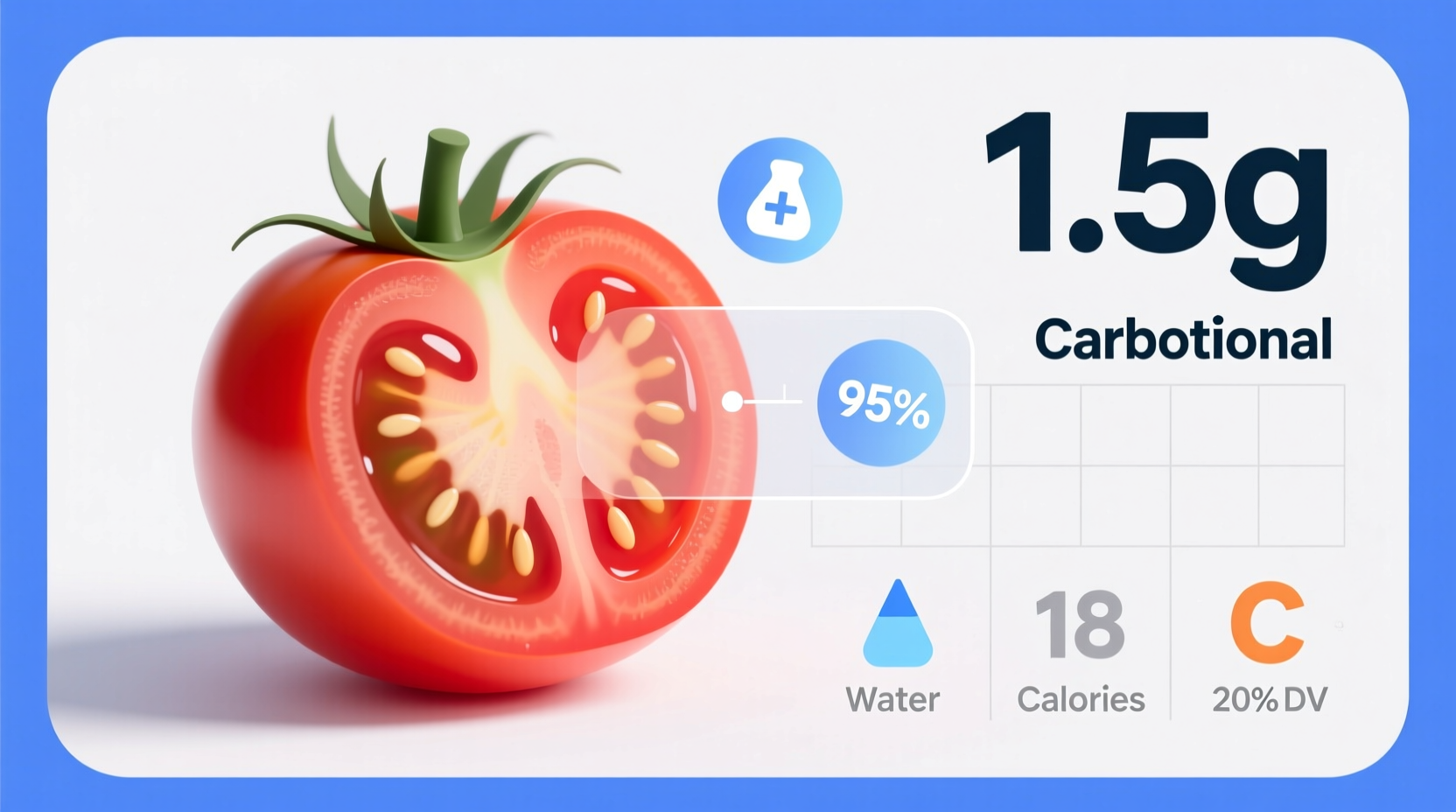Understanding Carbohydrates in Cherry Tomatoes: A Complete Guide
When tracking your daily carbohydrate intake for health, fitness, or dietary management purposes, knowing the exact carb content of commonly consumed foods becomes essential. Cherry tomatoes, with their sweet flavor and versatility in cooking, frequently appear in meal plans—but how many carbohydrates in a cherry tomato should you actually count?
Why Accurate Carbohydrate Information Matters
Whether you're managing diabetes, following a low-carb diet, counting macros for fitness goals, or simply making informed food choices, precise nutritional data prevents guesswork in your meal planning. Unlike larger tomato varieties, cherry tomatoes have a slightly different nutritional profile due to their higher skin-to-flesh ratio and concentrated sweetness.
Breaking Down Cherry Tomato Carbohydrates
The U.S. Department of Agriculture's FoodData Central database provides the most reliable nutritional information for American consumers. Their comprehensive analysis reveals exactly how carbohydrates are distributed in cherry tomatoes:
| Measurement | Total Carbohydrates | Dietary Fiber | Sugars |
|---|---|---|---|
| One cherry tomato (17g) | 0.6g | 0.2g | 0.4g |
| 100g serving | 3.53g | 1.2g | 2.54g |
| 1 cup (149g) | 5.26g | 1.8g | 3.78g |
This detailed breakdown shows that approximately 70% of carbohydrates in cherry tomatoes come from natural sugars, while the remaining 30% consists of dietary fiber—which means your body absorbs even fewer net carbs than the total count suggests.
How Cherry Tomatoes Compare to Other Tomato Varieties
Understanding the carbohydrate differences between tomato types helps you make informed substitutions in recipes. The USDA's nutritional database reveals these key distinctions:
- Cherry tomatoes: 3.53g carbs per 100g (higher sugar content due to concentrated flavor)
- Roma tomatoes: 3.09g carbs per 100g (lower moisture content affects carb density)
- Beefsteak tomatoes: 3.03g carbs per 100g (larger size dilutes sugar concentration)
- Tomato paste: 23.92g carbs per 100g (concentrated through cooking)
These variations matter significantly when following strict carbohydrate limits. For keto dieters, cherry tomatoes can be enjoyed in moderation, while those on more flexible low-carb plans might incorporate them more freely.
Practical Applications for Different Dietary Needs
Knowing how to apply this information in real-world scenarios transforms raw data into actionable knowledge:
For Keto and Very Low-Carb Dieters
With approximately 0.6g net carbs per cherry tomato (total carbs minus fiber), you can enjoy 10-12 cherry tomatoes while staying within typical keto limits. Pair them with high-fat foods like mozzarella or avocado to balance your macros.
For Diabetes Management
The glycemic load of cherry tomatoes remains low (approximately 1 per 100g) due to their fiber content and relatively low carbohydrate density. This makes them an excellent choice for blood sugar management when consumed as part of a balanced meal.
For Athletes and Active Individuals
Cherry tomatoes provide quick-digesting carbohydrates with valuable antioxidants. Consuming them before or after workouts delivers easily accessible energy while supporting recovery through their vitamin C and lycopene content.
Common Misconceptions About Tomato Carbohydrates
Several myths persist about tomato nutrition that can lead to inaccurate tracking:
- "All tomatoes have the same carb count": Size, variety, and ripeness significantly affect carbohydrate concentration
- "Cooked tomatoes have fewer carbs": Cooking concentrates carbohydrates as water evaporates—100g of cooked tomatoes actually contains more carbs than 100g raw
- "The color indicates sugar content": While redder tomatoes generally have more lycopene, sugar content varies more by variety than color alone

Maximizing Nutritional Value While Minimizing Carbs
You can optimize your cherry tomato consumption through these evidence-based approaches:
- Pair with healthy fats: Combining cherry tomatoes with olive oil or avocado increases absorption of fat-soluble nutrients like lycopene while slowing carbohydrate digestion
- Choose vine-ripened: Tomatoes allowed to ripen on the vine develop more complex sugars, potentially reducing glycemic impact compared to artificially ripened varieties
- Monitor portion sizes: Use a kitchen scale initially to verify your estimates—most people significantly underestimate serving sizes
How Nutritional Science Has Refined Our Understanding
Nutritional analysis of tomatoes has evolved significantly over time. Early 20th century food composition tables provided only crude estimates of "sugars" in vegetables. The development of chromatography techniques in the 1970s allowed scientists to distinguish between different sugar types. Modern mass spectrometry methods used by the USDA FoodData Central database now provide precise measurements of individual carbohydrate components, giving us the accurate counts we rely on today for dietary planning.
When Carbohydrate Counts Might Vary
Several factors can cause slight variations in the carbohydrate content of cherry tomatoes:
- Growing conditions: Soil composition and sunlight exposure affect sugar development
- Ripeness level: Fully ripe cherry tomatoes contain slightly more sugars than underripe ones
- Storage methods: Refrigeration can convert some starches to sugars over time
- Measurement technique: Whether you weigh tomatoes with or without stems affects precision
For most dietary purposes, the USDA's standardized values provide sufficient accuracy. Only those with extremely strict carbohydrate limits (such as therapeutic ketogenic diets for medical conditions) need to account for these minor variations.
Practical Tracking Tips for Daily Use
Implement these strategies to accurately track cherry tomato carbohydrates in your daily diet:
- Keep a small kitchen scale in your food prep area for quick verification
- When dining out, estimate cherry tomato portions as "about 1g net carbs per tomato" for quick mental math
- For salad preparations, weigh tomatoes before adding dressings to avoid counting extra carbs from sugary vinaigrettes
- When following recipes, calculate cherry tomato carbs separately from other ingredients for accuracy
Conclusion: Making Informed Choices
Understanding exactly how many carbohydrates in a cherry tomato empowers you to make precise dietary decisions without unnecessary restriction. With their favorable nutrient profile, vibrant flavor, and versatility in cooking, cherry tomatoes can be a valuable component of nearly any eating pattern when accounted for accurately. By using the USDA's verified nutritional data and applying these practical strategies, you can enjoy these delicious bite-sized tomatoes while staying confidently within your dietary goals.











 浙公网安备
33010002000092号
浙公网安备
33010002000092号 浙B2-20120091-4
浙B2-20120091-4